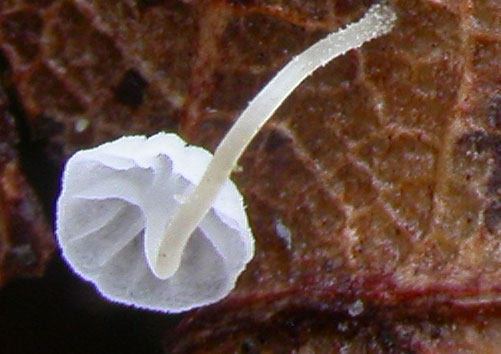| On fallen, decaying leaves
of Quercus. Also reported on leaves of Fagus. Late autumn.
Pileus 0.5-2.5
(-4) mm across, hemispherical, parabolical or convex, sometimes
centrally somewhat depressed, sulcate, hardly striate, puberulous
or granular puberulous, more or less glabrescent, very thin,
translucent in parts, white. Lamellae
(0-)4-8(-11) reaching the stipe, subhorizontal to slightly
arcuate, often very narrow, broadly adnate but not always
reaching the stipe, the edge straight to concave, white.
Stipe 5-50 x 0.1-0.2 mm, filiform,
flexuous, equal, pruinose, glabrescent for the greater part,
but puberulous at the base, watery white to white, occasionally
somewhat brownish at the base, insititious. Odour
none.
Basidia
15-18 x 8-10 µm, broadly clavate, 2-spored or 4-spored. Spores
(4-spored) 9-11.8 x 3.5-5 μm, Q = 1.9-2.4 or (2-spored) 10-13.5 x 3.5-5
µm, Q = 2.2-3.2, Qav ≈ 2.6, elongated pip-shaped, sometimes almost
cylindrical, smooth, amyloid. Cheilocystidia
15-27 x 8-15.5 μm, clavate, obpyriform, subcylindrical
to subglobose, covered with numerous, evenly spaced, warts or short
excrescences 1-2 µm long. Pleurocystidia
absent. Lamellar trama dextrinoid, vinescent in Melzer's reagent. Hyphae
of the pileipellis 2.5-20 μm wide,
densely covered with warts, with more or less inflated terminal celles. Hyphae
of the cortical layer of the stipe 1.8-5
µm wide, covered with cylindrical excrescences 1-5 µm
long. Caulocystidia
5-16 µm wide, clavate, covered with narrow, cylindrical excrescences. Clamp connections present in all tissues in 4-spored form; absent in 2-spored form.
Mycena polyadelpha has usually been
stated to be four-spored, but Maas Geesteranus (1983: 396)
described a two-spored form. Later (Maas Geesteranus 1986:
173) he indicated that two-spored forms are perhaps less
rare than originally thought. The Norwegian collections
seem to be mostly 2-spored.
Mycena polyadelpha is a member of
sect. Polyadelphia, and is characterized by the small
size, the white colour of the entire carpophore, the distant,
broadly adnate lamellae, the cheilocystidia covered with
warts, and the occurence on decaying oak leaves. It has
been reported from leaves of Fagus too (Maas Geeateranus,
1986: 173), and then it may be confused with M.
capillaris. There are only
very slight differences between the two species. M.
capillaris usually becomes greyish to pale greyish
brown at the centre of the pileus, the lamellae are more
narrowly adnate, the stipe is fairly dark grey-brown to
blackish in very young specimens, and the spores are narrower. Whether the records on Fagus leaves really represent M. polyadelpha, should be investigated by molecular methods.
There are several species of this section
growing on fallen Quercus leaves. M. bertaultiana
Moreno & Heykoop, M. catalaunica Robich and
M. smithiana Kühner
are characterized by pinkish colours. M. quercus-ilicis
Kühner is a species occuring in southern Europe.
Among several things it differs from M. polyadelpha
by having broadly pip-shaped to subglobose spores. M.
querciphila Esteve-Raventós & Villarreal,
known from Spain, differs in having a pale olive-yellow,
yellowish-brown to dark olivaceous-grey pileus and smooth
cheilocystidia. M. smithiana, usually with a pink colour on the cap, can occur in almost enyirely white forms, and then is very difficult to distinguish from M. polyadelpha.
Another tiny, white species growing on Quercus
leaves is M. mucor. It is characterized by a stipe with a small
basal disc, a separable, elastic pellicle, and cheilocystidia
with fairly few, long excrescences.
Microphoto of the hyphae of the pileipellis
Microphotos of cheilocystidia
Microphoto of spores
Go to key
to sect. Polyadelphia.

© A. Aronsen 2004
Further images on the Internet: |